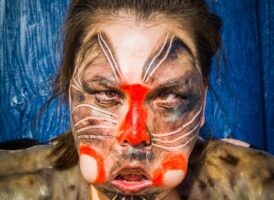Support Hidden Compass
Our articles are crafted by humans (not generative AI). Support Team Human with a contribution!
The sun slowly dips for the day, casting a golden glow across rice paddies in Shila and Ashok’s backyard. Their narrow, four-story house is located in the small Newari town of Panauti in Nepal. The Newari are a mixed race of Tibetan and Indian people who have called the rolling foothills of the Himalayas home for centuries.
It is the final day of my homestay with Sabita, Shila and Ashok’s neighbor. They have invited me over for a farewell dinner of Nepali chicken dumplings, called momo.
While our momos are steaming, Shila pulls out a rich, pomegranate-colored sari, which she skillfully wraps around my body. The material crackles from age, well-worn. Next, she outlines an intricate henna pattern that snakes up my fingers and the back of my palms, adorning my hands with beauty.
“One of my favorites,” she says, clasping a red bead necklace around my neck. Then she pulls out mascara and eye makeup, crusted from years of use, and sweeps color onto my brows and eyelids. As a final touch, she dips her thumb into turmeric.
“This is a sign of devotion,” Shila says, as she presses a red tika dot into the middle of my forehead, making a temporary indentation. She steps back to assess her work. Her face lights up with a smile.
“Thank you,” I say. “I never would have done it properly myself.”

Adorned in henna and marked by the tika dot of devotion, the author gets immersed in Newari culture in Nepal. Photo: Lola Akinmade Åkerström.
A rush of honor makes me giggle, which I temper with a smile of respect, my giddiness giving way to reverence.
I’m dancing along a precarious line. This instinctive discomfort — should I? — crops up any time I face the opportunity to wear a piece of culture, as if trying it on for size. Not all fabrics within a culture are created equal, regardless of print, pattern, or patchwork. Not all bear the same significance when draped over our bodies. Donning someone else’s ceremonial attire, I’ve learned, requires an invitation.
I know this because I am Yoruba. My tribe, specifically from the state of Ondo, is one of over 250 unique tribes in Nigeria, each with distinct versions of both festive and casual attire.
I wish this sari had been wrapped around me on my first day in Panauti, when, dressed for travel, I had arrived just in time to crash a wedding.
That was the day I first met Shila. As a greeting, she had sashayed toward me with a necklace fashioned from flowers, and gently placed it over my head, settling it around my neck with care. Like that red necklace of hers that currently sits on my neck. She wanted me to share some cultural solidarity with the other well-wishers, despite my jeans. She invited me to belong, if only for a fleeting moment.
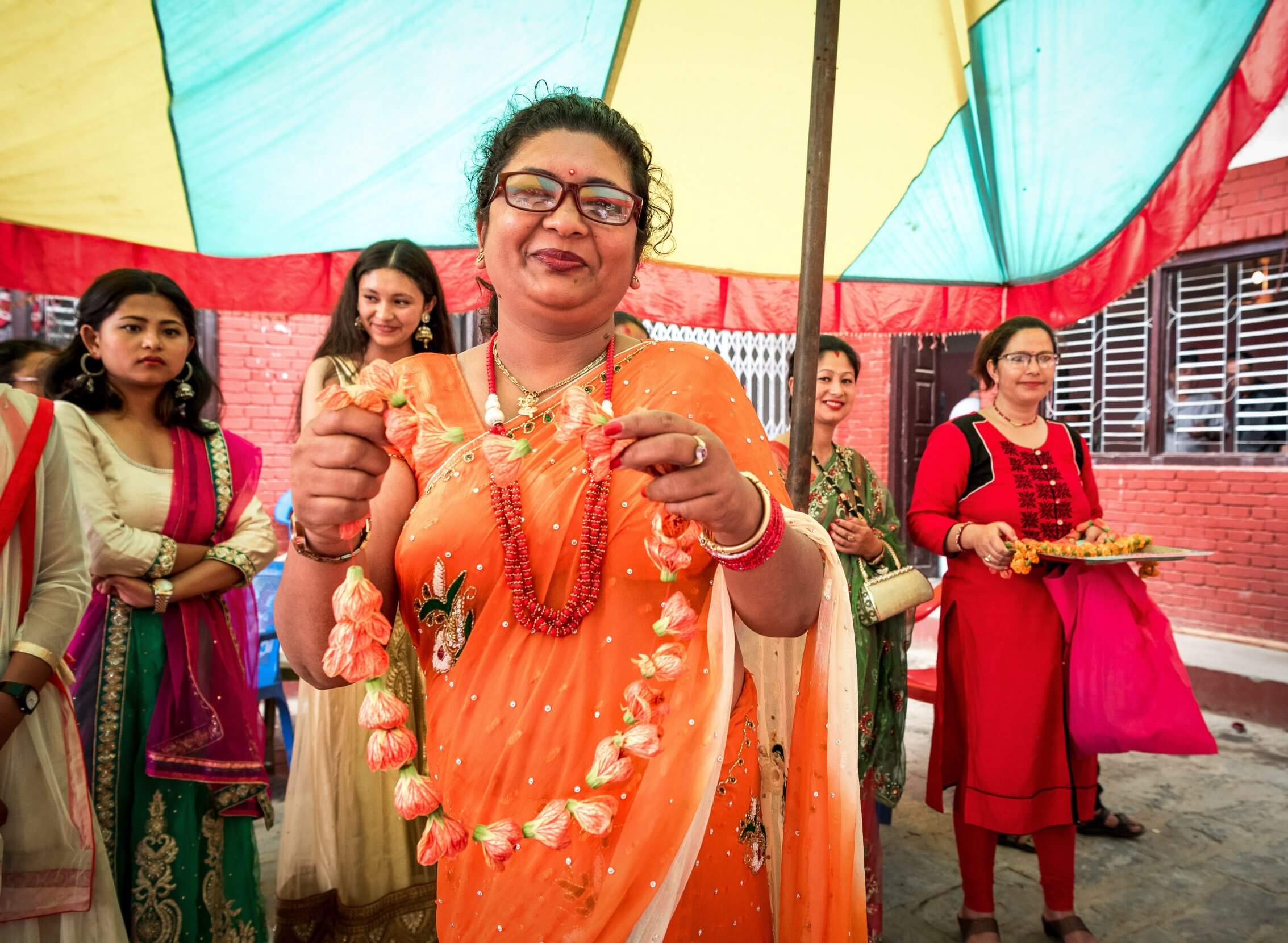
The author’s host in Nepal, Shila, welcomes her to wedding festivities with a floral garland. Photo: Lola Akinmade Åkerström.
I had turned toward the bride, who wore a lush, red veil embroidered with sequined crimson flowers and green leaves. A woman I assumed was her sister adjusted and perfected that veil over the bride’s hair, which was bejeweled with flowers and bands.
Heat of recognition rushed through me, and I took a picture.
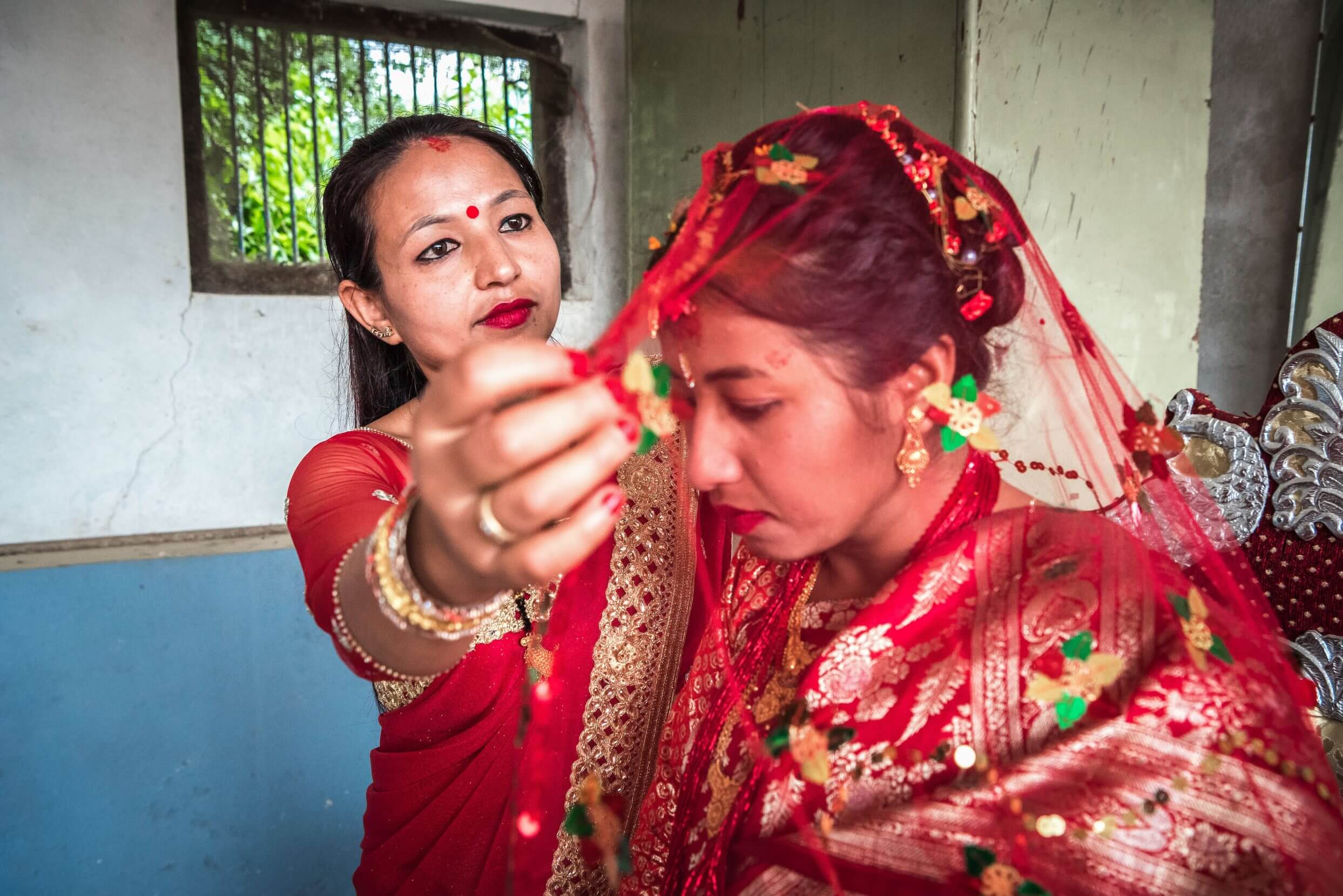
A bride in the Newari town of Panauti veils her face for her wedding ceremony. Nepalese bridal parties wear red as a symbol of purity and honor. Photo: Lola Akinmade Åkerström.
~~
“Wearing your gákti every day is like wearing a tuxedo to work,“ Sámi elder Anders tells me as we sit in a wooden lodge in Jukkasjärvi, roughly 20 minutes from Sweden’s northernmost town of Kiruna.
Before the Nordic countries of Norway, Sweden, and Finland carved their boundaries, their northernmost reaches, alongside Russia’s Kola Peninsula, collectively became known as Sápmi — home to an estimated 80,000 Indigenous Sámi.
“It’s like wearing your Sunday best for a grocery run, I imagine,” I say, chuckling.
I’m at the Nutti Sámi Siida Reindeer Lodge, run by Nils Torbjörn Nutti. Earlier that day, I’d gone reindeer sledding with Nils across frozen lakes and Arctic tundra, where snow-coated pine trees slipped by like ghosts. That night, my singular task was to chase shimmering auroras.
Anders estimates they’ll start dancing overhead by 9 p.m.
Sure enough, right on time, ribbons of swirling green lights begin to unfurl like curtains across the indigo-dark sky.
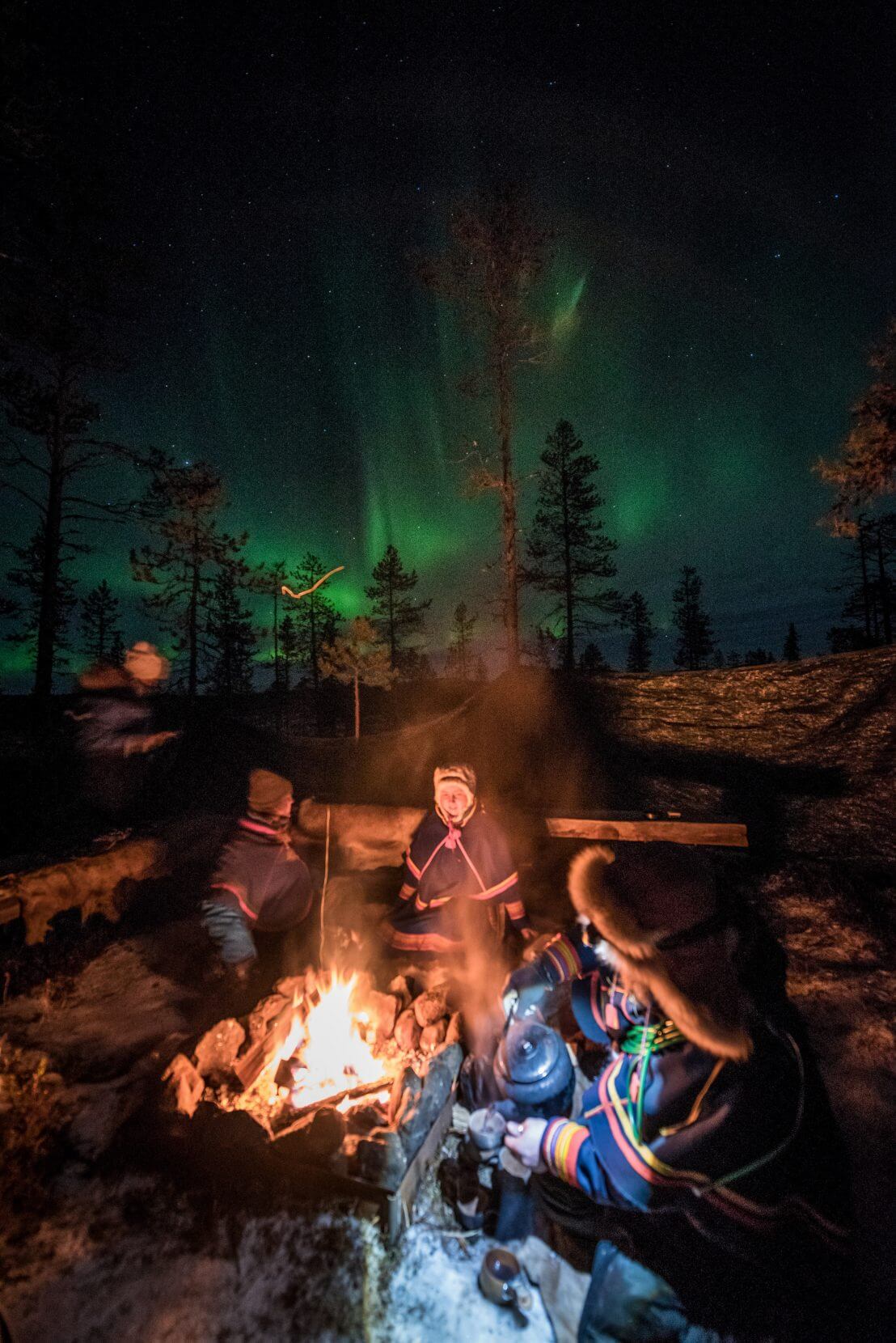
A group of Indigenous Sámi gather around a fire in their gákti — traditional attire worn for herding reindeer and in ceremonial contexts — as a swirl of green aurora borealis shrouds the night sky in northern Sweden. Photo: Lola Akinmade Åkerström.
I am overwhelmed.
Not by the lights — glorious displays I have been fortunate to witness before — but by Anders reading signs in nature. Observing the shape of the clouds, the direction of the wind, and other patterns around him, he avails himself of his seemingly intrinsic connection to the unspoken, which he effortlessly translates for me.
Soon enough, the Sámi culture lures me back from my home in Stockholm for another visit. On my second trip to Jukkasjärvi, I want to understand what the ceremonial gákti attire communicates without words.
Donning someone else’s ceremonial attire, I’ve learned, requires an invitation.
This time around, Nils is wearing what looks to me like a poncho when I meet him. I know Nils. My own roots in Indigenous culture compel me to show, with my curiosity, that I see him, too.
Nils explains that he’s dressed for work. This dark-blue tunic with prominent yellow and red embroidery, wrapped around his shoulders and covering the top half of his body, is called a luhkka. It helps block the wind and is simpler than a ceremonial gákti.
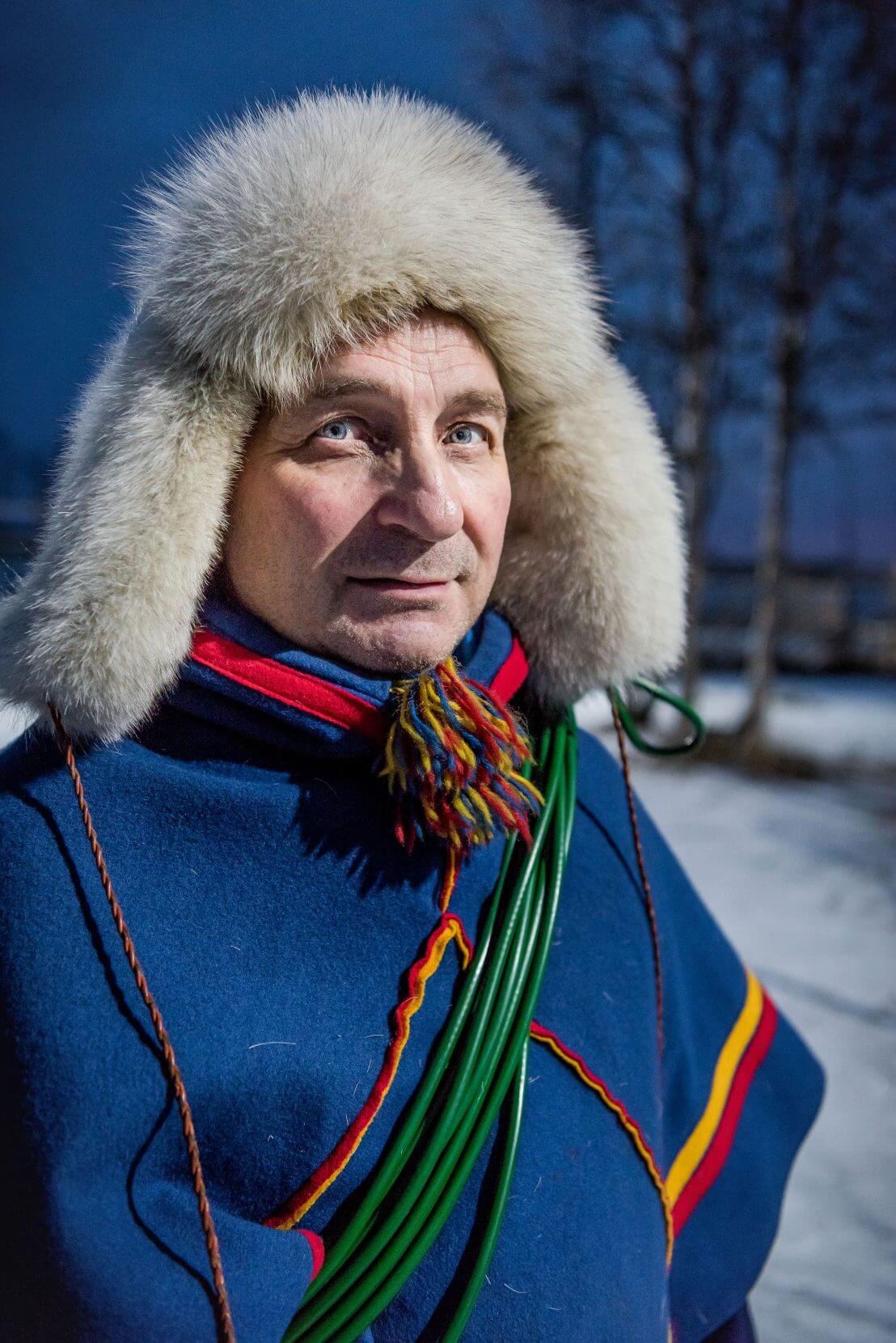
To block the wind of northern Sweden, Sámi reindeer herder Nils Torbjörn Nutti wears a poncho-like luhkka on the job. His red and yellow stitching identify that he comes from the Karesuando region in northernmost Sweden. Photo: Lola Akinmade Åkerström.
“We save our proper traditional dress for special occasions,” Nils says, as his fingers trace the yellow and red stitching woven along the hem of his tunic. The linear embroidery pattern denotes his origins, from a mountain village called Saarivuoma. Each gákti introduces its wearer on sight — where they hail from, which Sámi dialects they speak, even their marital status.
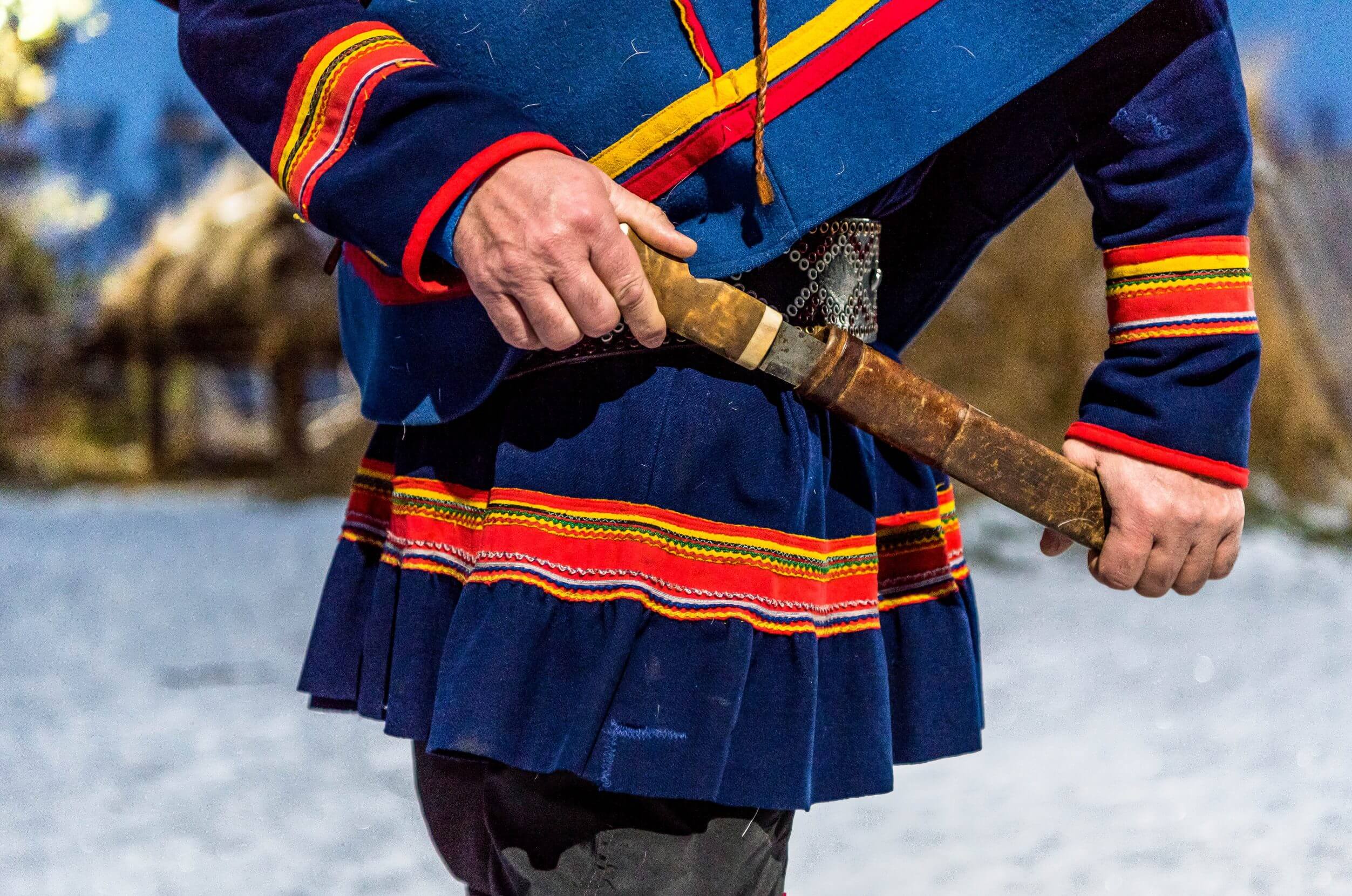
Sámi reindeer herder Nils Torbjörn Nutti brandishes a traditional knife — a tool with myriad uses in the Arctic wilderness — affixed to the belt of his gákti. Photo: Lola Akinmade Åkerström.
Nils’s explanation unknowingly forms a deeper cultural bond. The same way my own ceremonial attire, called aso oke, signifies to another Yoruba tribe member that I am specifically from Ondo, his gákti is his visual DNA. Commissioning a gákti for myself, even if done as a sign of appreciation, would never make sense.
~~
I think of Nils’s luhkka when I see a similar swaddle of thick cloth — black with a red band — around Idja Lotta Stoor’s broad shoulders. She greets me with a warm smile, her gray-blue eyes twinkling behind chic, black-rimmed glasses. Once again, Indigenous culture has pulled me back to the north, to the Sámi town of Jokkmokk.
Beneath Lotta’s luhkka is a blue gákti dress with yellow and red horizontal bands running along its hems. On top she has layered a black shawl with long fringes, loosely tied around her neck. I note that its palette — black, red, yellow, blue — pulls directly from the traditional attire she wears underneath.
“Gákti is formal wear, but we also need beautiful things inspired by Sámi style,” she says.
Lotta and her partner, Piera Niilá Stålka, run a boutique, Stoorstålka, which sells their signature shawls and scarves, leather belts, trays, homeware, and beanie caps, among other items, inspired by gákti designs. I am standing inside their modest shop, its warmly lit storefront a beacon in the subarctic darkness.
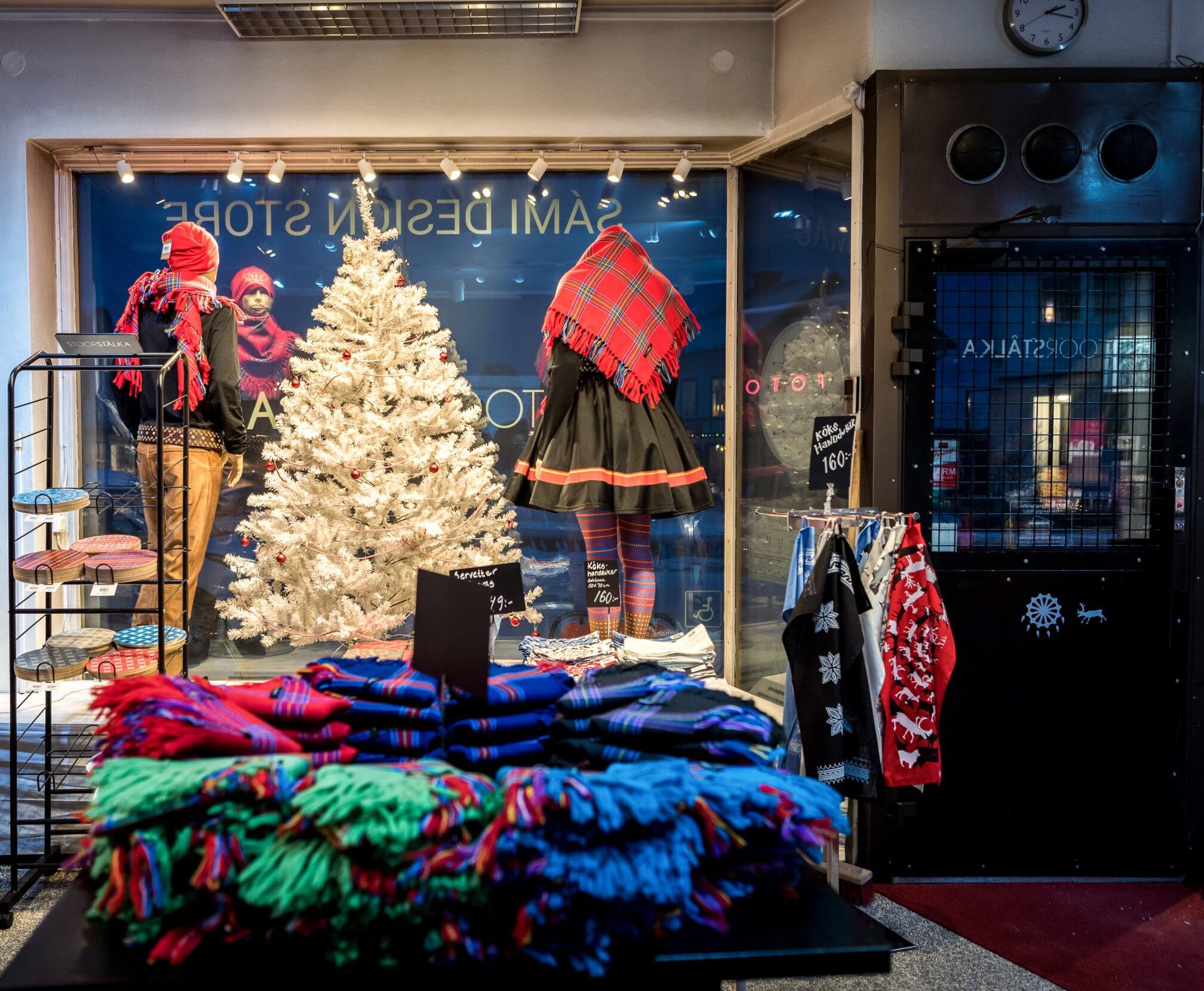
Sámi designers Piera Niilá Stålka and Idja Lotta Stoor sell scarves, home goods, beanie caps, and other accessories inspired by gákti designs in their modern boutique in Jokkmokk, Sweden. Photo: Lola Akinmade Åkerström.
I buy two wool shawls — red and midnight blue — and hesitantly wrap one around my shoulders, craving a sense of connection. This is the closest I will get to wearing an original gákti, but I’m wary of playing “dress up” with someone else’s cultural heritage.
Lotta assures me I need not worry about stepping out of bounds. This is why they do this, both shop owners stress. With Lotta’s roots in Jukkasjärvi and Piera Niilá from here in Jokkmokk, they know how and what to design for the masses without buyers risking cultural appropriation.
I sigh with relief. It is necessary work, this temporal discomfort — this education of what is ceremonial and what is casual, this attention to where appreciation turns to disrespect.
Lotta steps back and meets me with an approving smile, just like Shila did, and it mitigates my feelings of insecurity.
~~
Līga’s gaze burns with a laser focus as her eyes sweep over her work. Her hands intricately outfit me in medieval-inspired Latgalian folkwear — a thick wool skirt, handwoven blue scarf, and a cascade of heavy pewter and bronze jewelry weighing down my bust.
My mind races and I feel myself holding my breath. I’m afraid that if I let out air, I may break, tear, or pop something she has carefully arranged on my body.
“Are you married?” she asks.
Her question feels random, but I reply, “Yes, I am.” She covers my head with a linen cloth.
“The outfit is worn this way because you are married,” she adds.
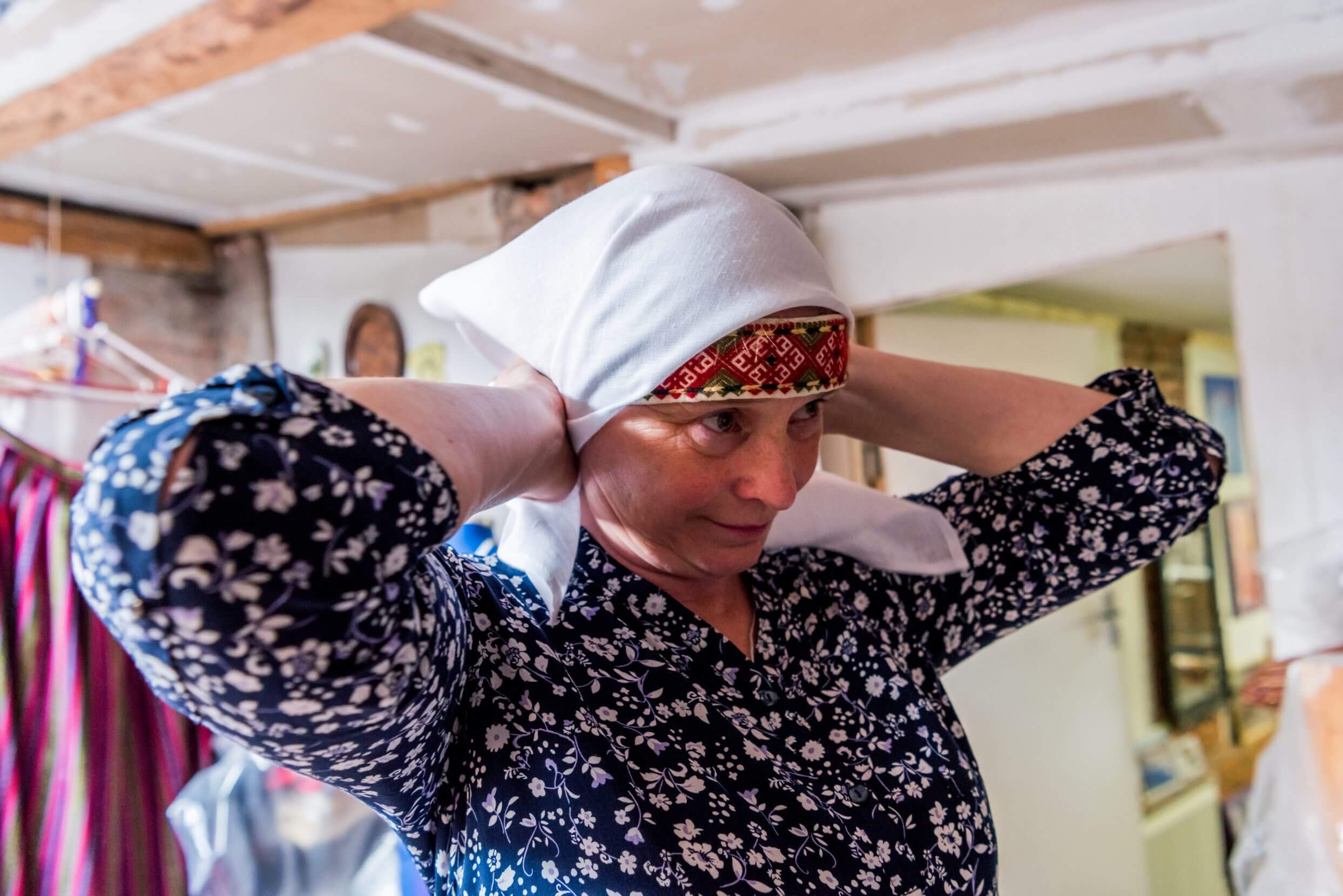
In the Latgalian folk traditions of Latvia, a linen head covering — like the one Līga wears here — reveals a woman’s status as married. Photo: Lola Akinmade Åkerström.
The power of the moment, and my privilege to receive it, are not lost on me. She is draping history over my shoulders.
I’m in one of the most remote regions of Latvia, called Latgale, in the 840-plus-year-old town of Ludza, being granted rare access into one of the oldest living cultures of the Baltics. The transfer of heritage is visceral as Līga’s fingers delicately place fragile jewelry on my limbs, and around my neck, and smooths out the cloth so it falls gracefully across my body.
Finally, Līga takes a few steps back to assess her work with a smile.
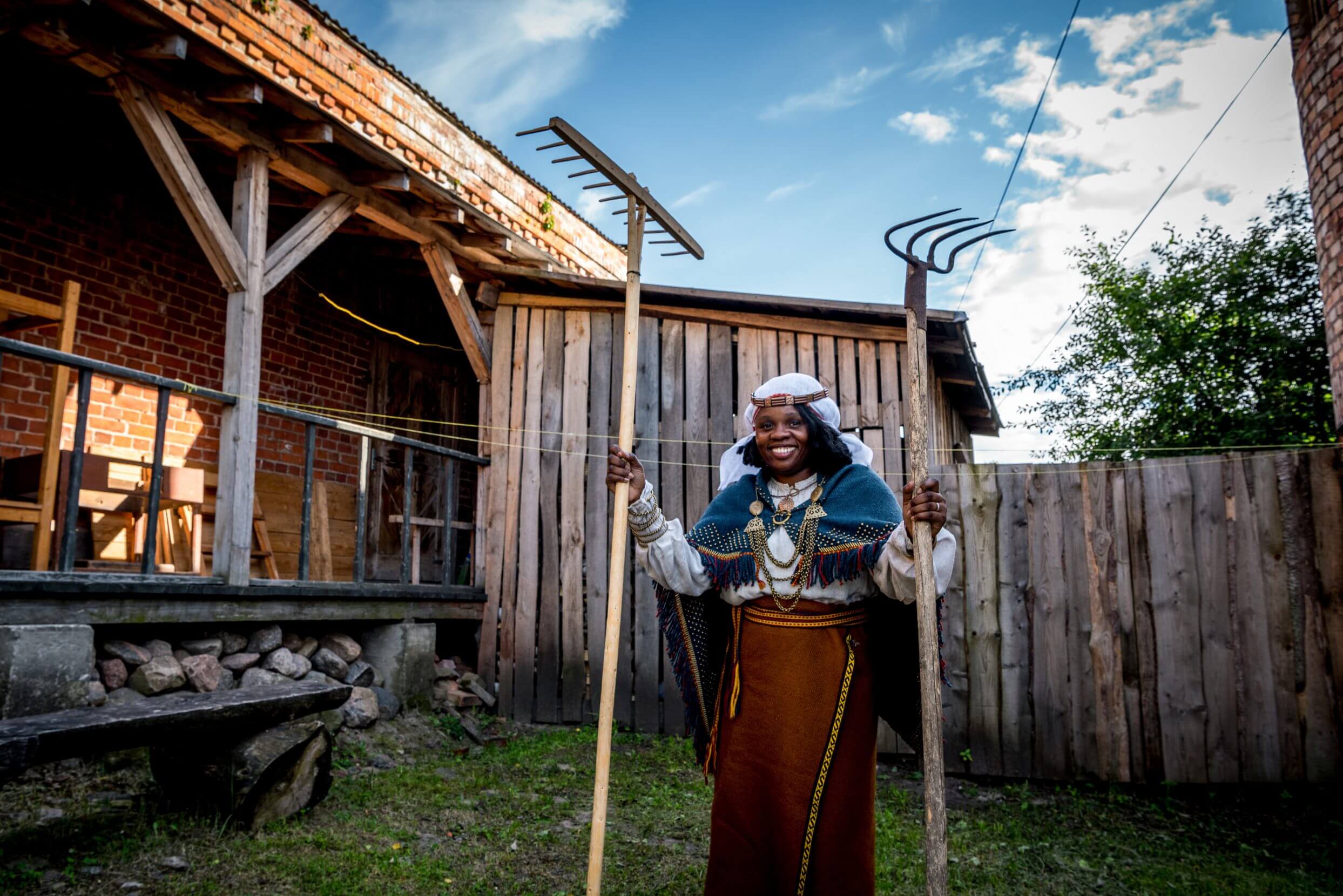
The author proudly tries on Latgalian folk attire that has roots in ninth-century Latvia. Photo: Lola Akinmade Åkerström.
My own roots in Indigenous culture compel me to show, with my curiosity, that I see him, too.
~~
I am at home in Nigeria, wearing a lush, green veil.
Through the sheer fabric, I see our guests mill around a green-tinted world. They dance in a uniform sea of colors — various shades of olive and chartreuse — to show cultural solidarity, as well-wishers.
Aso ebi, we call it in Yoruba. The attire of the well-wisher.
Beneath my veil, I fan myself in the June heat with a matching, soft-feathered hand fan as beads of sweat race down my face. They trickle down from under my gele — the iconic, elevated head tie of my Yoruba tribe. Despite the guttural sounds of air-conditioners fighting to be heard over the boisterous crowd, I am sweating under the weight of my aso oke.
The literal English translation of aso oke means “top cloth,” denoting an attire of high status in Yoruba. Aso oke is made from heavy, handwoven silk and we sew it into agbada and fila for men (a flowing, wide-sleeved robe and hat) as well as iro and gele for women (wrapper and head tie). We only wear it for special occasions, from weddings and funerals, to chieftaincy title ceremonies.
As a child, I loved seeing my parents wear their aso oke with pride. The deep maroonish hue, almost purple, roots us in place. Our place: Ondo. Wearing it says we belong.
For this occasion, I chose green because it is my favorite color and my traditional wedding.
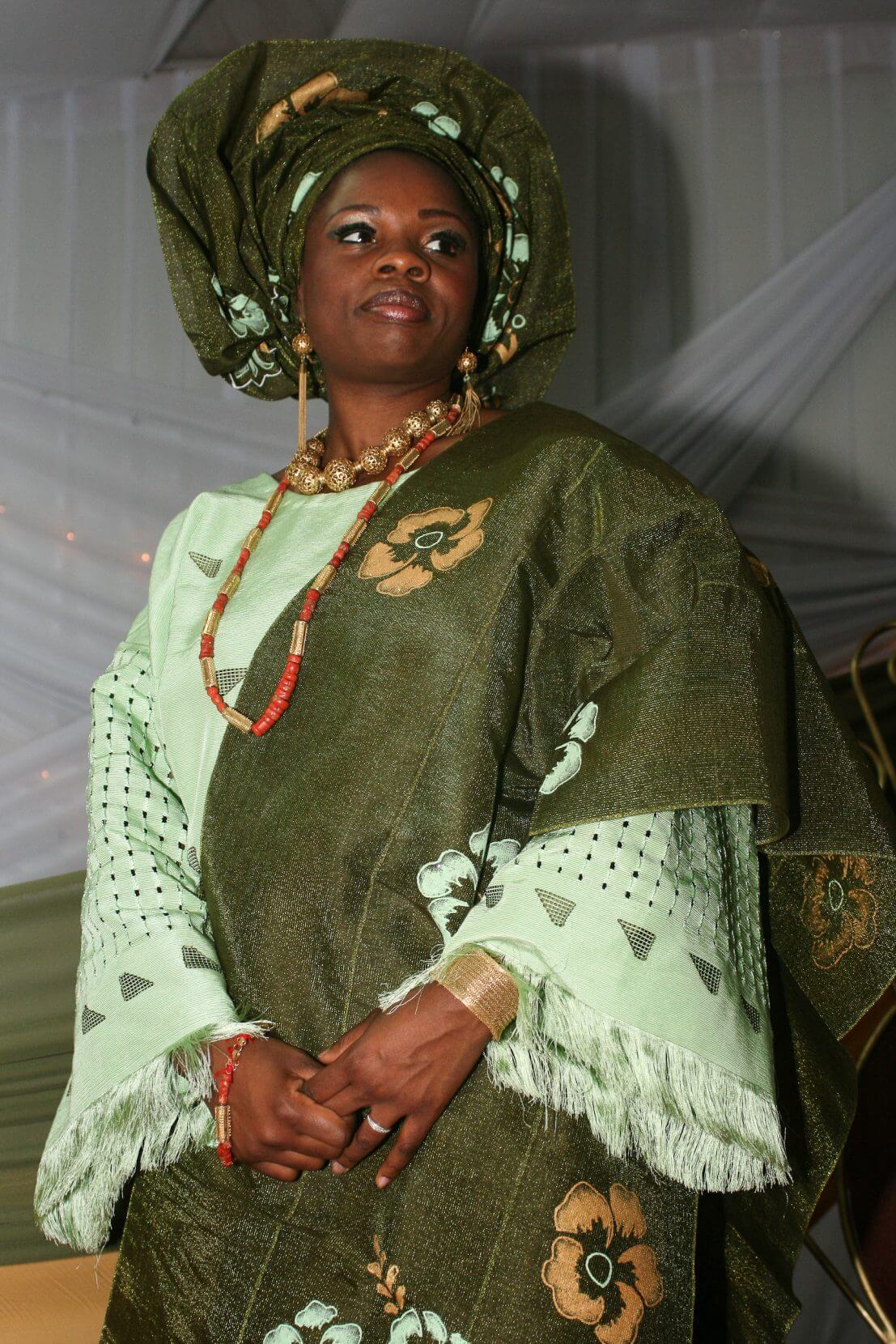
From head tie to toes, the author is a vision in chartreuse — her chosen color for her wedding in her native Nigeria. Heavy handwoven silk makes up the aso oke — “top cloth” — of Yoruba ceremonial attire, which culminates in an elevated gele tied on top. Photo: Lola Akinmade Åkerström.
I observe my parents now as they glide with pride in their own Ondo aso oke, slowly dancing, while guests gyrate around them in celebration, honoring them on behalf of me, the bride.
The festive noise suddenly pitches several decibels and I know what is happening.
He’s finally here.
My heart swells with pride as I see the foreigner, mechanically fidgeting off rhythm, respectfully wearing a fila too small for his head, and an agbada too broad for his chest. My brother-in-law and father have properly dressed this foreigner with care.
This Swede, wearing aso oke, will become my husband. I look at him and grin.
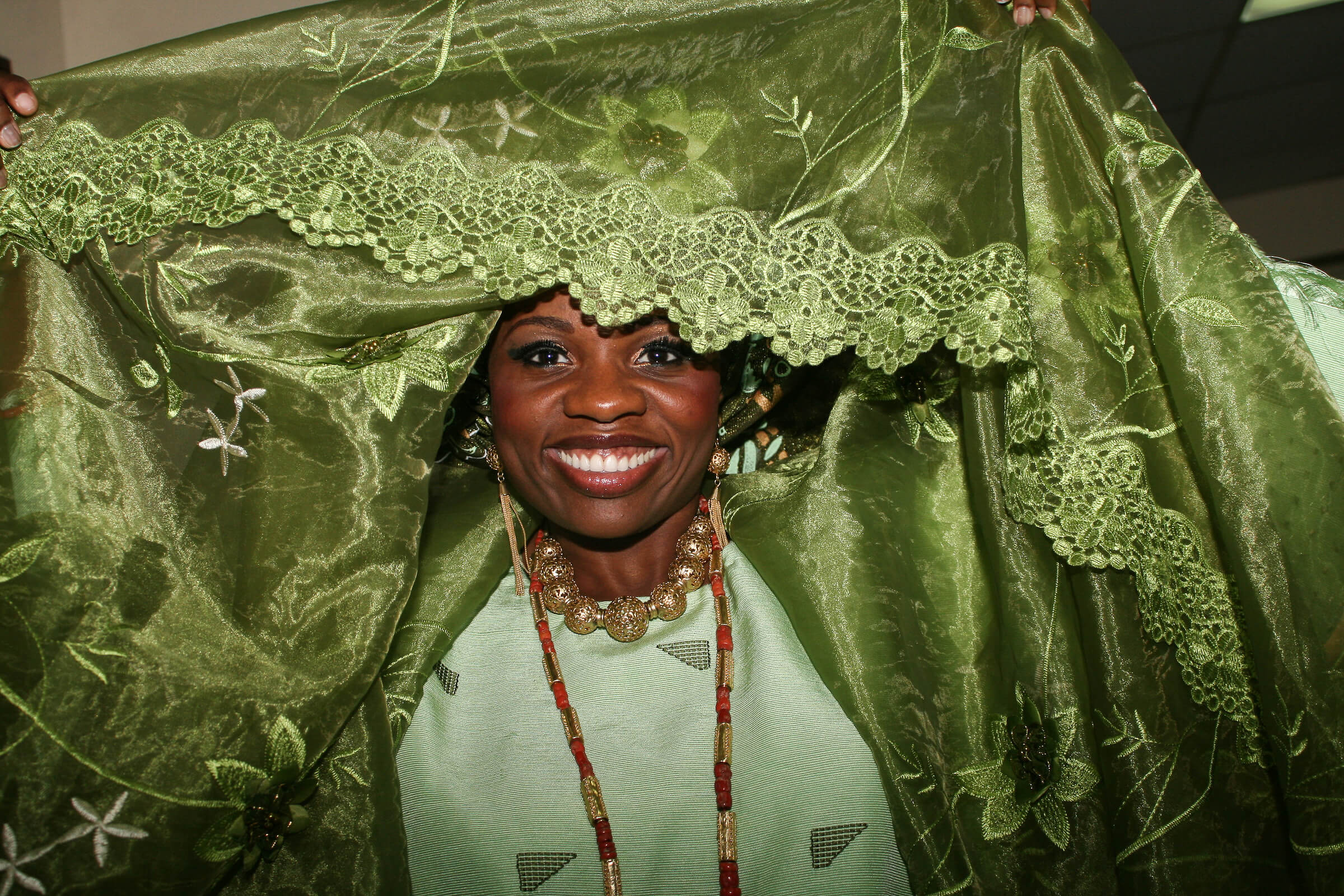
At the author’s traditional Yoruba wedding in Nigeria, she lifts an ornate green veil to show her beaming face. Photo: Lola Akinmade Åkerström.
Lola Akinmade Åkerström
Lola Akinmade Åkerström is the 2023 Pathfinder Prize-winning expedition leader and cinematic art director for “In Tété’s Footsteps: A Cultural Expedition in Greenland.”



